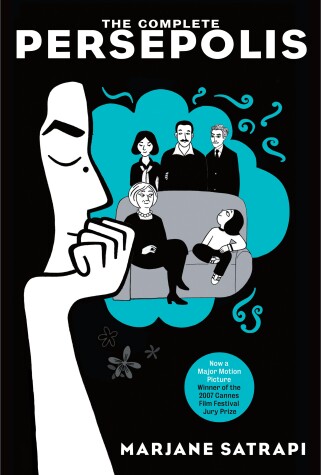Reviewed by Rach Wood on
Narrated with monochromatic illustrations, it stands out eloquently, despite its simplicity, and proves to be intelligent, fun and moving. Marjane Satrapi unveils not only her memories as a woman growing up in Iran during the Islamic Revolution, but she also conveys, in a profoundly human way, a universal message of freedom and tolerance.
Satrapi, the first Iranian woman to write comics, addresses the great changes her country has faced through a personal narrative, consisting of 39 chapters, which allows us to follow her from childhood to adulthood. We are exposed to customs and family and social relationships as part of the history of Iran, from 1978 to the 1990s.
In 1979, the Iranian Revolution took place, which ousted the Shah, the representative of the monarchy, and established the Islamic Republic. Marjane Satrapi was just 10 years old when Western customs, previously practised, were banned. It's within a modern and avant-garde family that she will have to find a balance between the religion she was born with and the education she grew up with.
As a child, Marjane Satrapi, who had gone to a French laic school where boys and girls learned together, is faced with the mandatory use of the veil and the separation of genders. In street demonstrations for and against the veil, her mother screamed for the pro-freedom faction.
Marjane knew a lot about the revolution, especially since her parents insisted that she read about it. Her favourite work was, however, a comic strip, called Dialectical Materialism, in which Marx and Descartes appeared. One day, she said: “For the revolution to succeed, it has to have the support of the entire population.” But it was too dangerous.
During her childhood, Marjane experiences the revolution against Islamic morals through family stories. From her father, who reveals to her that the deposed emperor was the father of her grandfather. From her mother, who confesses the fear she felt as a child every time she heard a knock at the door. From her grandmother, who lived in poverty and pretended to cook so the neighbours wouldn't notice. From political prisoners, friends of her parents. From her uncle Anoosh, who was in prison for nine years. From whoever was willing to tell her a new story.
But, from an early age, Marjane also embraces Western culture. Despite her love for the Persian tradition, she still wanted to wear Nike sneakers, shave her legs and listen to Kim Wilde and Iron Maiden. Because she questioned the rules and knew how to scream louder than her attacker, her parents ended up sending her to Austria so she could live in safety.
It was in Vienna that the author lived her adolescence. After meeting Julie, Momo, Olivier and Thierry, she discovered anarchism and Bakunin, the history of the commune and Sartre, the favourite author of her companions. At that time, she read a lot to understand everything, but never forgot that we have to understand ourselves first.
For some time she was far from her culture, even denying her own nationality. At the time, “Iran was the epitome of evil” and being an Iranian was a difficult burden to carry.
Throughout Persepolis, Marjane defines herself as a rebellious, progressive and emancipated woman in the face of religious fundamentalism. Her work is a singular testimony that, in Ruth Leys' expression, is “inherently political and collective”, also presenting itself, and for that reason, as cultural memory.
Reading updates
- Started reading
- Finished reading
- 17 July, 2021: Reviewed
